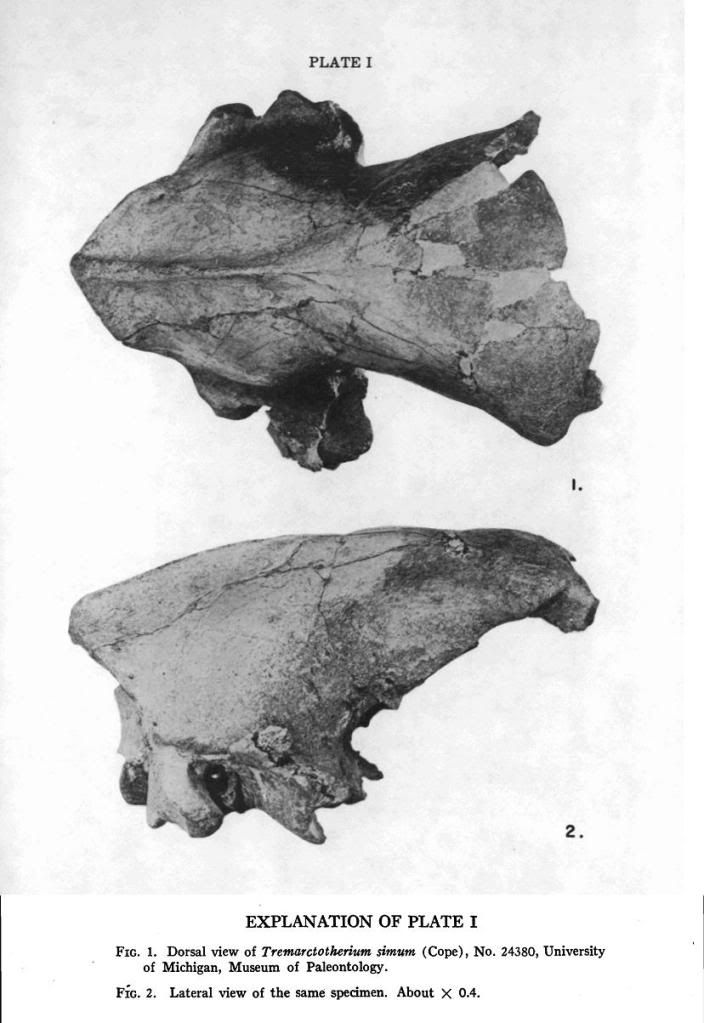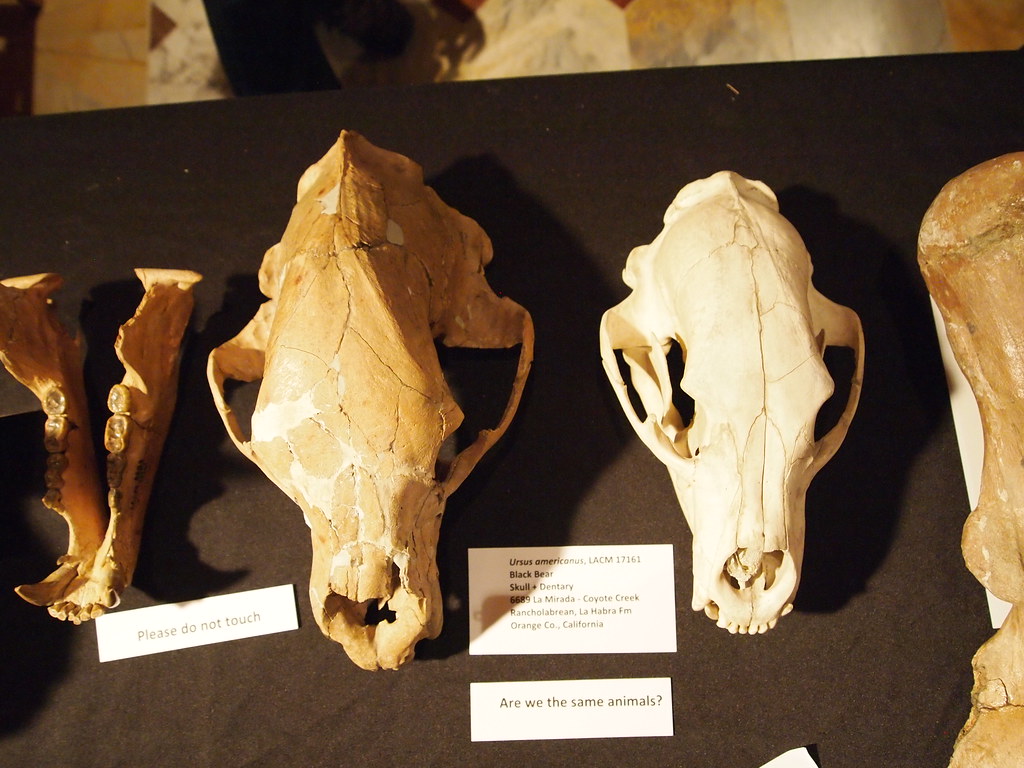|
|
Post by grrraaahhh on Mar 7, 2011 17:27:03 GMT -9
 Middle Pleistocene (Baryshnikov 2010). |
|
|
|
Post by grrraaahhh on Mar 10, 2011 23:32:54 GMT -9
 Above: Partial skull of a large Pleistocene short faced-bear (Kansas, USA). |
|
|
|
Post by grrraaahhh on May 27, 2011 14:29:00 GMT -9
Scotland: Ancient bones those of brown bear An almost complete skeleton recovered after years of work from a cave in the Scottish Highlands has been confirmed as that of a male brown bear. The pieces of bone were recovered by cavers exploring a network of caves at Inchnadamph in Sutherland. Previously the remains of a polar bear were found at the site. The National Museums of Scotland in Edinburgh said tests have established the most recent bones found were those from a brown bear. The first pieces were discovered in 1995 by cavers exploring a network of caves at Inchnadamph in Sutherland. But it was only last year that caving club, Grampian Speleological Group, reached some of the final fragments. Cave divers spent 12 years crawling through narrow spaces and moving soil to unblock entrances in their effort to recover all that they could of the bear [...] news.bbc.co.uk/2/hi/uk_news/scotland/highlands_and_islands/8028831.stm
|
|
|
|
Post by grrraaahhh on Aug 27, 2011 17:34:53 GMT -9
 Black Bear? Black Bear?This is the skull of a black bear next to a fossil skull from Orange County. The fossil skull is much bigger and has a more pronounced forehead. It almost looks like a grizzly skull. Scientists are looking into whether it's a black bear or a different species. This table was about local ice age fossils that were from sites other than the La Brea Tar Pits. www.flickr.com/photos/jobaria/5779604062/ |
|
|
|
Post by grrraaahhh on Feb 12, 2012 19:37:37 GMT -9
Craig Wagnell found this bear jaw bone lodged in the ceiling of cave in Port Alberni. It is currently showcased at the Qualicum Beach Museum.  67,000 Year Old Bear Jaw Bone (Craig Wagnell photo). Source: www.portaec.net/local/karst/caver.html |
|
|
|
Post by grrraaahhh on Feb 13, 2012 17:07:40 GMT -9
|
|
|
|
Post by grrraaahhh on Feb 13, 2012 17:17:35 GMT -9
|
|
|
|
Post by grrraaahhh on Feb 18, 2012 8:20:00 GMT -9
Atapuerca Mountains (Spain): Fauna - Sima de los Huesos  Surrounded by darkness, ancestors of the cave bears (`Ursus deningeri´) entered the Cueva Mayor looking for a secluded but convenient corner to hibernate, waiting for the fruits the spring will bring. It is cold outside. A bear and her cub find the perfect spot inside the Sala de los Ciclopes, and there they make themselves comfortable. Another young adult, however, prowls around in his search of the cave and, attracted by the pleasant smell of carrion, reaches the mouth of a sinkhole some 13 meters deep: he is facing the Sima de los Huesos. The odor coming from the dark bottom is more intense there, putting all his instincts on alert, which are more focused now on the climb down to the source of such delicacies. The rough descent ends with a hard fall, but despite being injured, he gets the desired taste of rotting meat from some of the carcasses accumulated there. Sadly, there is no way out but the vertical shaft, now impossible to ascend. The intrepid young bear has fallen in a natural death trap, and his lifeless remains will feed the constant string of bears, foxes, weasels, and many other carnivores that subsequently fall in. The Sima de los Huesos also contains human remains which represent an early mortuary practice and their presence can be explained differently from that of the carnivores. This combination of taxa, humans and carnivores with no evidence of herbivores, is completely unknown for a place considered to be a home or shelter for humans. This large accumulation, biased in favor of carnivores, indicates that they came here attracted by a good reason: food. Almost 180 bears, one wolf, 25 foxes, three lions, two lynxes, one wild cat, three weasels, one beech marten, three European polecats, and one European badger accumulated over the years in the Sima around half a million years ago. The preNeandertal human bodies were deposited at the Sima for different reasons. Bears, PawsAmong the fossils extracted from the upper sediments at Sima de los Huesos, there is no evidence of lithic manufacture or herbivores: something very unusual in deposits of the same time period. This accumulation was composed exclusively of bears (more than 150) and other carnivores: three lions, twenty four foxes, some wolves, lynx, and mustelids. The research done by Trinidad Torres had established the identity of the bear in question as `Ursus deningeri´, the ancestor of the formidable cave bear typical of the Upper Pleistocene. Its size was superior to that of a great European brown bear, and it was specialized as an omnivore, with less preference for meat than extant bears. The Sala de las Oseras is closed due to a collapse inside the cave, in a point that according to the maps, it is located a couple of meters away from the roof of the Sima. This cavity is named after the presence of hibernation beds, a sort of nest made on the floor clay where these animals spend the winter. Some cracks in the cave wall are filled with clay and still preserve paw prints made by the bears’ claws, so fresh that they seem recent. A small excavation in the Sala de las Oseras discovered dozens of almost intact bones from `Ursus deningeri´. There were remains of every kind: juvenile and adult bears with cubs accumulated along the walls. It was here where the last of their species moved the bones aside to make their own beds. In contrast, the bears whose remains were founded at the Sima de los Huesos didn’t hibernate there. This part of the cave has functioned for a long time as a natural trap. Its mouth is tight and difficult to pass through, and the 13 meter abyss opens without warning in a corner of the cave apparently ideal for sleeping for several months. If a bear looking for a place for its winter’s nap gets distracted, it might fall in. This was what happened to 160 of them over several millennia. Many of them didn’t die instantly. Wounded and trapped in a pit with no way out, their agony would have been slow, and their survival instinct led them to scavenge the remains of other equally unfortunate fellow bears that had fallen previously, moving and crushing the bones in the process, until in the end, they died. When this happened, the flesh did not last long (just months) before disappearing, and their skeleton remained in the same position as at the moment of death until some other unfortunate individual, sometimes a mother with her cubs, fell over them, little by little forming an ossuary. For more, read here: www.atapuerca.tv/atapuerca/fauna_huesos.php?idioma=EN
|
|
|
|
Post by grrraaahhh on Oct 6, 2012 4:38:41 GMT -9
|
|
|
|
Post by grrraaahhh on Jul 16, 2013 10:10:50 GMT -9
Deciduous teeth morphology of some tremarctines (Ursidae, Tremarctinae). Descriptions, comparisons and possible phylogenetic implications Leopoldo Soibelzon, Alfredo Carlini Abstract. The morphology of some deciduous teeth of Arctotherium tarijense Ameghino and A. angustidens Gervais and Ameghino (Ursidae: Tremarctinae) is here described and compared for the first time. The crown morphology of dP4 and dp4 is similar to that of M1 and m1. The general morphology of dP/dp4b in A. tarijense and Ursinae is similar, but their permanent dentition morphology is different. The dP/dp4 of A. tarijense seem to bear a generalized set of characters (i.e. crown outline, the protocone and parastyle of dP4, the metaconid and hypoconid of dp4); unfortunately these teeth cannot be compared with their homologues in other tremarctines. Consequently, we are unable to include these characters in the phylogenetic analysis of the Tremarctinae subfamily in order to know whether the phylogenetic relationships are affected or not. It is interesting to note, that had these characters been present in M/m1 of A. tarijense, at least, some of them could be undoubtedly regarded as plesiomorphic features. In this respect, is the deciduous teeth morphology more conservative than that of permanent teeth? MORFOLOGÍA DE LOS DIENTES DECIDUOS DE ALGUNOS TREMACTINOS (URSIDAE, T REMARCTINAE). DESCRIPCIONES, COMPARACIONES Y POSIBLES IMPLICANCIAS FILOGENÉTICAS.Resumen.Se describe y compara la morfología de algunos dientes deciduos de Arctotherium tarijense Ameghino and A. angustidens Gervais and Ameghino (Ursidae, Tremarctinae) por primera vez. La morfología del dP4 y dp4 es muy similar a la del M1 y m1. La morfología general de los dP/dp4 en A. tarijense y Ursinae es similar, aunque la morfología de sus dientes definitivos es muy diferente. Los dP/dp4 de A. tarijense parecen poseer un conjunto de caracteres generalizados (en relación con el contorno de la corona, el protocono y el parastilo del dP4, el metacónido y el hipocónido del dp4). Desgraciadamente no es posible comparar esas piezas con sus homólogas en otros tremarctinos, por lo que no es posible incluir estos caracteres en el análisis filogenético de la subfamilia Tremarctinae con el fin de saber si sus relaciones filogenéticas se ven afectadas o no. Es importante remarcar que si esos carcateres estuviesen presentes en los M/m1 de A. tarijense, al menos algunos de ellos podrían ser interpretados como plesiomorfías. En este sentido, ¿la morfología de los dientes deciduos es más conservadora que la de los definitivos? PDF LINK: www.google.com.et/url?sa=t&rct=j&q=deciduous%20teeth%20morphology%20of%20some%20tremarctines%20(ursidae%2C%20tremarctinae).%20descriptions%2C%20comparisons%20and%20possible%20phylogenetic%20implications&source=web&cd=1&cad=rja&ved=0CCgQFjAA&url=http%3A%2F%2Fsedici.unlp.edu.ar%2Fbitstream%2Fhandle%2F10915%2F5378%2FDocumento_completo.pdf%3Fsequence%3D1&ei=8gvlUcnjLYfLOL-ugPgG&usg=AFQjCNEKPNSA3qWDZu6t0XcgXpTd8eoNvg&bvm=bv.48705608,d.ZWU
|
|